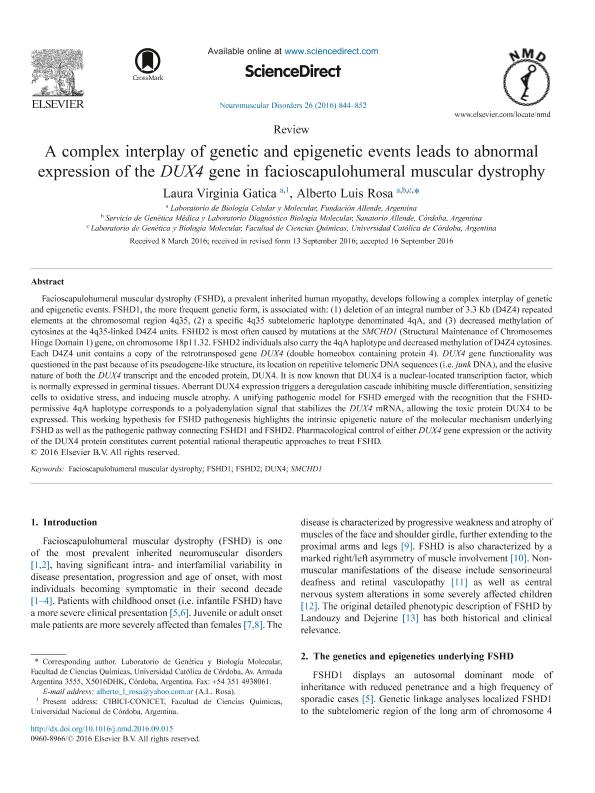Mostrar el registro sencillo del ítem
dc.contributor.author
Gatica, Laura Virginia

dc.contributor.author
Rosa, Alberto Luis

dc.date.available
2018-06-11T13:57:31Z
dc.date.issued
2016-12
dc.identifier.citation
Gatica, Laura Virginia; Rosa, Alberto Luis; A complex interplay of genetic and epigenetic events leads to abnormal expression of the DUX4 gene in facioscapulohumeral muscular dystrophy; Pergamon-Elsevier Science Ltd; Neuromuscular Disorders; 26; 12; 12-2016; 844-852
dc.identifier.issn
0960-8966
dc.identifier.uri
http://hdl.handle.net/11336/48049
dc.description.abstract
Facioscapulohumeral muscular dystrophy (FSHD), a prevalent inherited human myopathy, develops following a complex interplay of genetic and epigenetic events. FSHD1, the more frequent genetic form, is associated with: (1) deletion of an integral number of 3.3 Kb (D4Z4) repeated elements at the chromosomal region 4q35, (2) a specific 4q35 subtelomeric haplotype denominated 4qA, and (3) decreased methylation of cytosines at the 4q35-linked D4Z4 units. FSHD2 is most often caused by mutations at the SMCHD1 (Structural Maintenance of Chromosomes Hinge Domain 1) gene, on chromosome 18p11.32. FSHD2 individuals also carry the 4qA haplotype and decreased methylation of D4Z4 cytosines. Each D4Z4 unit contains a copy of the retrotransposed gene DUX4 (double homeobox containing protein 4). DUX4 gene functionality was questioned in the past because of its pseudogene-like structure, its location on repetitive telomeric DNA sequences (i.e. junk DNA), and the elusive nature of both the DUX4 transcript and the encoded protein, DUX4. It is now known that DUX4 is a nuclear-located transcription factor, which is normally expressed in germinal tissues. Aberrant DUX4 expression triggers a deregulation cascade inhibiting muscle differentiation, sensitizing cells to oxidative stress, and inducing muscle atrophy. A unifying pathogenic model for FSHD emerged with the recognition that the FSHD-permissive 4qA haplotype corresponds to a polyadenylation signal that stabilizes the DUX4 mRNA, allowing the toxic protein DUX4 to be expressed. This working hypothesis for FSHD pathogenesis highlights the intrinsic epigenetic nature of the molecular mechanism underlying FSHD as well as the pathogenic pathway connecting FSHD1 and FSHD2. Pharmacological control of either DUX4 gene expression or the activity of the DUX4 protein constitutes current potential rational therapeutic approaches to treat FSHD.
dc.format
application/pdf
dc.language.iso
eng
dc.publisher
Pergamon-Elsevier Science Ltd

dc.rights
info:eu-repo/semantics/openAccess
dc.rights.uri
https://creativecommons.org/licenses/by-nc-sa/2.5/ar/
dc.subject
Dux4
dc.subject
Facioscapulohumeral Muscular Dystrophy
dc.subject
Fshd1
dc.subject
Fshd2
dc.subject
Smchd1
dc.subject.classification
Otras Ciencias Biológicas

dc.subject.classification
Ciencias Biológicas

dc.subject.classification
CIENCIAS NATURALES Y EXACTAS

dc.title
A complex interplay of genetic and epigenetic events leads to abnormal expression of the DUX4 gene in facioscapulohumeral muscular dystrophy
dc.type
info:eu-repo/semantics/article
dc.type
info:ar-repo/semantics/artículo
dc.type
info:eu-repo/semantics/publishedVersion
dc.date.updated
2018-05-30T18:21:11Z
dc.identifier.eissn
1873-2364
dc.journal.volume
26
dc.journal.number
12
dc.journal.pagination
844-852
dc.journal.pais
Países Bajos

dc.journal.ciudad
Amsterdam
dc.description.fil
Fil: Gatica, Laura Virginia. Fundación Allende; Argentina. Consejo Nacional de Investigaciones Científicas y Técnicas. Centro Científico Tecnológico Córdoba. Centro de Investigaciones en Bioquímica Clínica e Inmunología; Argentina
dc.description.fil
Fil: Rosa, Alberto Luis. Fundación Allende; Argentina. Sanatorio Allende; Argentina. Universidad Católica de Córdoba; Argentina
dc.journal.title
Neuromuscular Disorders

dc.relation.alternativeid
info:eu-repo/semantics/altIdentifier/doi/http://dx.doi.org/10.1016/j.nmd.2016.09.015
dc.relation.alternativeid
info:eu-repo/semantics/altIdentifier/url/https://www.sciencedirect.com/science/article/pii/S0960896616300876
Archivos asociados
